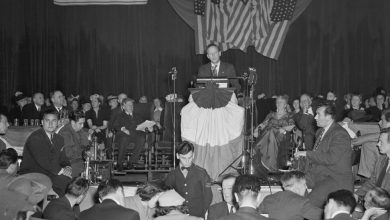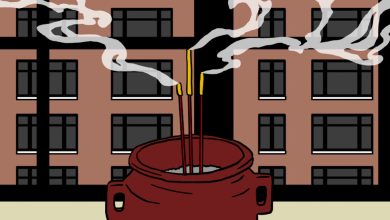How a Mapmaker Became New York’s Most Unexpected Power Broker

He is a postdoctoral fellow from Pittsburgh, a bartender turned political mapmaker. Now, Jonathan Cervas is suddenly New York’s most unforeseen power broker.
Last month, a New York State judge chose Mr. Cervas to create new district maps in New York for the House and State Senate, after maps approved by state Democratic leaders were declared unconstitutional.
Mr. Cervas’s new maps radically reshaped several districts, scrambling the future of the state’s political establishment for the next decade. Republicans were quietly pleased, and some anti-gerrymandering groups praised his work. But Democrats, who saw several potential pickups in the House of Representatives potentially evaporate, were outraged.
Mr. Cervas’s decisions — the rationale for which he outlined in a lengthy explanation released early Saturday — have already caused vicious infighting and prospective primaries between some incumbent Democrats, including one pitting Representatives Jerrold Nadler and Carolyn Maloney against each other in Manhattan.
For his part, Mr. Cervas, 37, insists he was just doing his job, the importance of which he says has been exaggerated by the fact that the state’s changes came so late in the 2022 election cycle.
“People have made a narrative how the House of Representatives is going to be determined by one man who is from Pennsylvania; nothing could be further from the truth, ” he said in a lengthy interview this week, adding that “people still have to run” for office.
“I serve the court, I serve democracy. That’s it,” he added. “If people want to make me important, so be it, but I just stick with my moral principles and things I’ve learned and apply the law as its written.”
That said, the impact of Mr. Cervas’s circumscription has already been profound, creating the likelihood of highly competitive general-election campaigns from Long Island to upstate New York. Some races in the New York State Senate, where Democrats hold a comfortable majority, have also been upended by new lines.
Representative Hakeem Jeffries, who represents parts of Brooklyn and Queens, was particularly galled by the congressional changes, likening the new lines to “Jim Crow” laws — which restricted Black involvement in voting and other aspects of society — and skewering Mr. Cervas’s work as having “degraded the Black and Latino populations in five New York City-based congressional districts.”
“The unelected, out-of-town special master did a terrible job, produced an unfair map that did great violence to Black and Latino communities throughout the city, and unnecessarily detonated the most Jewish district in America,” said Mr. Jeffries, who is chairman of the House Democratic Caucus and the second-highest-ranking Black lawmaker in Congress. “That’s problematic and that cannot be excused or explained in any fair or rational fashion.”
What to Know About Redistricting
- Redistricting, Explained: Here are some answers to your most pressing questions about the process that is reshaping American politics.
- Understand Gerrymandering: Can you gerrymander your party to power? Try to draw your own districts in this imaginary state.
- Killing Competition: The number of competitive districts is dropping, as both parties use redistricting to draw themselves into safe seats.
- Deepening Divides: As political mapmakers create lopsided new district lines, the already polarized parties are being pulled even farther apart.
Mr. Cervas said that his map “fully reflected” how many of New York’s largest minority populations — including Black, Latino, and Asian groups — are “geographically concentrated.”
As for Mr. Cervas’s political beliefs, they are somewhat hard to divine. He describes his political leanings as “pro-democracy,” rather than professing allegiance to any party, though he adds that belief happens “to align more closely with one party than another.” He is registered as an independent in Pennsylvania, where he lives, but he says he recently voted in a Republican primary there in hopes of electing moderate members of that party.
What’s more, he says he hates politics, preferring institutions and policy to electoral battles.
“I like governance,” Mr. Cervas said. “I don’t really like the bickering, the animosities, the games. Those types of things are uninteresting to me.”
Mr. Cervas was appointed as a so-called special master by Justice Patrick F. McAllister of State Supreme Court in Steuben County, who ordered new maps drawn up after a successful lawsuit from Republicans. Justice McAllister, a Republican, found that Democratic lawmakers in Albany had adopted lines that were “unconstitutionally drawn with political bias.”
Mr. Cervas’s was appointed in mid-April, after Nate Persily, a Stanford law professor who helped draw New York’s current congressional map in 2012, turned down Justice McAllister.
His previous work had been as an assistant on more limited redistricting cases in Georgia, Virginia and Utah. Last year, however, Mr. Cervas was hired for a statewide project, as part of a redistricting commission in Pennsylvania, where the chairman, Mark Nordenberg, said he proved invaluable as a redistricting specialist, as well as having “a deep knowledge of the law” and, of course, “technical, mapping skills.”
“He approached everything we did in a fair and nonpartisan fashion,” said Mr. Nordenberg, the former chancellor of the University of Pittsburgh, noting he “would hire him again if I had the opportunity.”
That said, Mr. Cervas had never been a special master, particularly on such a tight deadline: about five weeks to deliver the final maps, including and incorporating revisions. He worked with several assistants and solicited comments from the public, both online and in a single, in-person hearing in Steuben County, about 275 miles from New York City.
And while the remoteness of that location made court appearances cumbersome, some anti-gerrymandering advocates made the trip to voice support for the new maps.
“I have to say I was pleasantly surprised,” said Jerry Vattamala, the director of the Democracy Program at the Asian American Legal Defense and Education Fund, which was part of a coalition lobbying for more representation for people of color in New York City, adding that Mr. Cervas seemed responsive to the thousands of comments he received. “So the six-hour drive, I guess, was worth it.”
In some ways, Mr. Cervas seems destined to have played an outsize role in Democratic woe: He was born, outside Pittsburgh, on Election Day in 1984, when Ronald Reagan humiliated the party’s nominee, Walter Mondale, winning a second term. His upbringing — in two swing states — was working-class: His father was a field service representative for Whittle Communications, his mother worked at Kmart.
The family moved to Las Vegas in the early 1990s, and Mr. Cervas became interested in politics, eventually studying the topic at the University of Nevada-Las Vegas and graduating with a degree in political science. He supported himself by working in a movie theater at a casino and eventually tending bar, a job he said helped him learn how to listen to divergent opinions.
“It’s actually an education on how to be moderate,” he said. “When people say things that are inflammatory, you have to not take it too personally. ”
If there was a turning point in the road for Mr. Cervas, it may have come nearly a decade ago at a rock concert in Anaheim, Calif.
How U.S. Redistricting Works
What is redistricting? It’s the redrawing of the boundaries of congressional and state legislative districts. It happens every 10 years, after the census, to reflect changes in population.
Why is it important this year? With an extremely slim Democratic margin in the House of Representatives, simply redrawing maps in a few key states could determine control of Congress in 2022.
How does it work? The census dictates how many seats in Congress each state will get. Mapmakers then work to ensure that a state’s districts all have roughly the same number of residents, to ensure equal representation in the House.
Who draws the new maps? Each state has its own process. Eleven states leave the mapmaking to an outside panel. But most — 39 states — have state lawmakers draw the new maps for Congress.
If state legislators can draw their own districts, won’t they be biased? Yes. Partisan mapmakers often move district lines — subtly or egregiously — to cluster voters in a way that advances a political goal. This is called gerrymandering.
What is gerrymandering? It refers to the intentional distortion of district maps to give one party an advantage. While all districts must have roughly the same population, mapmakers can make subjective decisions to create a partisan tilt.
Is gerrymandering legal? Yes and no. In 2019, the Supreme Court ruled that the federal courts have no role to play in blocking partisan gerrymanders. However, the court left intact parts of the Voting Rights Act that prohibit racial or ethnic gerrymandering.
Want to know more about redistricting and gerrymandering? Times reporters answer your most pressing questions here.
Mr. Cervas, still bartending, had traveled across state lines to see the Killers, staying near the University of California at Irvine.
“I saw it,” he said of the university. “And I really liked it.”
He applied and was accepted to graduate school, where he would build out the roots of what has become a career-long obsession with redistricting and the effects of gerrymandering.
He began studying with Bernard N. Grofman, a noted political scientist and redistricting expert at Cal-Irvine who “changed my life,” according to Mr. Cervas. In particular, Mr. Grofman encouraged Mr. Cervas’s interest in gerrymandering as well as geographic information systems, sophisticated mapping software that can incorporate reams of data.
Mr. Grofman recalls a hard-working student, likening him to a knowledge-soaking sponge who could map “at least three times faster” than his professor.
Mr. Cervas became a research assistant for Mr. Grofman, who was appointed special master on a series of cases, including one involving the Navajo Nation in Utah, which sued over school board and the county commission districts. The federal courts found those districts unconstitutional, and the subsequent remapping seems to have affirmed Mr. Cervas’s commitment to his work.
“We drew lines that empowered the Navajo Native Americans,” he said. “Nothing felt as great as that moment when I had a direct impact on people’s lives. And that continues on every one of these cases.”
Indeed, there is no doubt Mr. Cervas’s work in New York — the nation’s fourth largest state, with some 20 million people — will affect lives, and political careers, as well. He says he’s been surprised by the attention paid to his lines, if a little disappointed by the concerns over the electoral consequences.
“Everyone was focused on the horse-race politics, and nobody was focused on how clean our map was,” he said.
Mr. Cervas says he’s still an optimist about the nation’s democratic processes and believes that most Americans, like himself, are opposed to “the nefarious nature of gerrymandering.”
“It’s pretty much universal that the public is against these things,” he said. “I think people would rather win fair and square.”
For his part, Mr. Grofman says that he feels the critiques of Mr. Cervas have missed how difficult it can be sometimes to account for various criteria like equal population and representation, contiguity and compactness.
“There’s like 10 different things you have to balance,” he said. “You can’t do everything that everybody wants.”
Nicholas Fandos contributed reporting.





